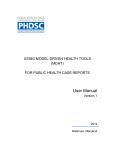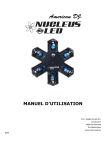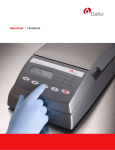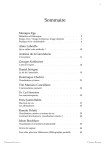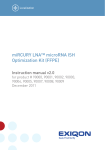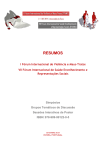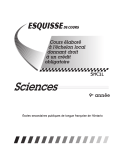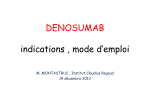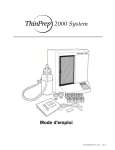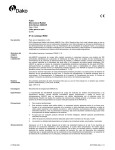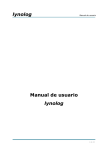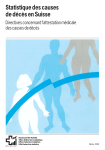Download Herceptest™ Interpretation Manual - Breast Cancer
Transcript
E DUCAT ION HercepTestTM Interpretation Manual Breast Cancer E DUCAT ION HercepTestTM Table of Contents Contents 5 Introduction 6 HER2 Overview 6 HER2 Protein and HER2 Family 6 HER2 Testing IHC and FISH 7 HER2 Testing Algorithm 8 The HercepTestTM Kit 9 9 HER2 IQFISH pharmDxTM Kit Hybridizer Instrument for In Situ Hybridization (FISH) 10 Checklist 10 HercepTestTM Training Checklist 11 11 Recommendations Recommended Data Tracking for HercepTestTM Immunostaining 12 Technical Considerations 12 Technical Considerations for Optimal HercepTestTM Performance 12 Protocol Recommendations 13 Tissue Processing Considerations 13 Tissue Processing Recommendations 14 Guidelines 14 Review of HercepTestTM Scoring Guidelines 14 Validation of the Assay 15 Interpretation Guide for 1+ Cell Line 16 Guidelines for Scoring 17 17 17 19 24 24 28 29 30 31 31 Interpretation Recommendations for Interpretation of HercepTestTM – Breast Cancer Steps for HercepTestTM Interpretation Staining Patterns Artifacts Interpreting Artifacts Effects of Fixation Effects of Insufficient Target Retrieval Effects of Excessive Tissue Drying Staining Images HER2 Expression in Various Diagnostic Entities 46 Troubleshooting Guide 46 Troubleshooting Guideline for HercepTestTM 49 Bibliography 4 HercepTestTM Interpretation Manual – Breast Cancer ROW Version Introduction HercepTestTM Interpretation Manual HercepTest™ is a semi-quantitative immunohistochemical assay to determine HER2 protein overexpression in breast cancer tissues routinely processed for histological evaluation and formalin-fixed, paraffin-embedded cancer tissue from patients with adenocarcinoma of the stomach, including the gastroesophageal junction*. HercepTest™ is indicated as an aid in the assessment of breast and gastric cancer patients for whom Herceptin® (trastuzumab) treatment is being considered (see Herceptin® package insert). HercepTestTM Interpretation Guidelines Prior to HercepTestTM, immunohistochemistry was practiced largely as a subjective method, ideally suited for qualitative analysis. HercepTestTM, however, changed this paradigm, as the determination of positivity was no longer a simple yes or no answer. Patients are now evaluated using immunohistochemistry technology applied as a semi-quantitative tool with a scoring system reflective of intensity of staining in conjunction with percentage of stained tumor cells. This shift in application introduced a change in the way immunohistochemistry was viewed. Most metastatic breast cancer tissue specimens tested for HER2 overexpression are scored with either 0 or 3+ staining intensity. While the majority of cases are clear-cut, a small percentage of the remaining 1+ and 2+ scored samples may be more difficult to interpret. In this manual, we will focus on these equivocal samples. In addition, we will review images of sample artifacts and discuss how to best interpret such cases. HER2 IQFISH pharmDxTM Despite the high quality of HercepTestTM, clinical response of weakly positive specimens has remained an area of uncertainty within HER2 assessment. HER2 IQFISH pharmDxTM complements HercepTestTM by quantitatively determining HER2 gene amplification and clarifying equivocal cases. HercepTestTM and HER2 IQFISH pharmDxTM enhance patient care by aiding in proper determination of the appropriate course of treatment. Photomicrographs The included photomicrographs are breast carcinoma unless otherwise noted. This HercepTestTM Interpretation Manual for breast cancer is provided as a tool to help guide pathologists and laboratorians to achieve correct and reproducible results. The goal of this manual is to familiarize you with the requirements for scoring breast carcinomas stained with HercepTestTM. Example cases of various staining intensities of HER2 expression are provided for reference. The HercepTestTM package insert guidelines will be reviewed and technical tips for ensuring high-quality staining in your laboratory will be given. Reviewing this HercepTestTM Interpretation Manual will provide a solid foundation for evaluating slides stained with HercepTestTM. * Van Cutsem E, Kang Y, Chung H, Shen L, Sawaki A, Lordick F, et al. Efficacy results from the ToGA trial: A phase III study of trastuzumab added to standard chemotherapy in first-line human epidermal growth factor receptor 2 positive advanced gastric cancer. J Clin Oncol 2009;27:18s, (suppl; abstr LBA2409). (http://media.asco.org/silver). Dako is a registered trademark of Dako Denmark A/S. HercepTestTM and Herceptin® are trademarks owned by Genentech, Inc. and/or F. Hoffman-La Roche Ltd.; HercepTestTM is subject to an exclusive trademark license to Dako Denmark A/S. HercepTestTM Interpretation Manual – Breast Cancer ROW Version 5 HER2 Overview HER2 Protein and HER2 Family The gene encoding HER2 is located on chromosome 17 and is a member of the EGF/erbB growth factor receptor gene family, which also includes epidermal growth factor receptor (EGFR, or HER1), HER3/erbB3 and HER4/erbB4. All of these genes encode transmembrane growth factor receptors, which are tyrosine kinase type 1 receptors with growth stimulating potential. Activation of HER family members generally occurs when the ligand and a dimer of the same monomer or other member of the HER family are bound together. HER2 has no known ligand. Once activation has occurred, tyrosine autophoshorylation of cytoplasmic signal proteins transmit signals to the nucleus, thus regulating aspects of cell growth, division, differentiation and migration. Overexpression of HER2 receptors results in receptors transmitting excessive signals for cell proliferation to the nucleus. This may lead to more aggressive growth of the transformed cell. Data supports the hypothesis that the HER2overexpression cells directly contribute to the pathogenesis and clinical aggressiveness of tumors.* This overexpression is associated with poor prognosis, including reduced relapse-free and overall survival. Ligand HER2 Homodimer HER Heterodimer Growth Signal Figure 1: Representation of HER family HER2 Testing IHC and FISH Immunohistochemistry (IHC) measures the level of HER2 receptor overexpression, while fluorescence in situ hybridization (FISH) quantifies the level of HER2 gene amplification. Together they are the most commonly used methods of determining HER2 status in routine diagnostic settings. HER2 DNA (Target for ISH) HER2 Protein (Target for IHC) Nucleus HER2 mRNA Cytoplasm Cell Membrane Amplified Result, Score ≥ 2 Breast cancer specimen stained with HER2 IQFISH pharmDxTM. Breast Cancer Cell Positive Result, Score 3+ Breast cancer specimen stained with HercepTestTM. Figure 2: IHC and ISH targets for HER2 testing * Robert W. Carlson, MD; Susan J. Moench, et al. HER2 Testing in Breast Cancer: NCCN Task Force Report and Recommendations: Journal of the National Comprehensive Cancer Network July 2005. | Edith A. Perez, Vera J. Suman, et al. HER2 Testing by Local, Central and Reference Laboratories in Specimens from the North Central Cancer Treatment Group N9831 Intergroup Adjuvant Trial. Journal of Clinical Oncology July 1, 2006. | Martine J. Piccart-Gebhart, MD., Ph.D., Marion Proctor, M. Sci., et al. Trastuzumab after Adjuvant Chemotherapy in HER2-Positive Breast Cancer. New England Journal of Medicine October 20, 2005. 6 HercepTestTM Interpretation Manual – Breast Cancer ROW Version HER2 Testing Algorithm Tumor Sample HER2 IHC 0 Negative 1+ Negative 2+ Weakly Positive* 3+ Positive HER2 ISH Negative Non-Amplified Positive Amplified Report to Oncologist for Herceptin® Consideration Figure 3: Current clinical practices for selection of patients for Herceptin® treatment. * For Herceptin® – Weakly positive cases (2+) may be considered equivocal and reflexed to ISH testing. NCCN Practice Guidelines in Oncology, CAP Conference Summary Laboratories performing HER2 testing should meet quality assurance standards. HercepTestTM Interpretation Manual – Breast Cancer ROW Version 7 The HercepTestTM Kit HercepTestTM is a semi-quantitative immunohistochemical kit system for determination of HER2 protein overexpression in breast cancer tissues routinely processed for histological evaluation and in formalin-fixed, paraffin-embedded cancer tissue from patients with adenocarcinoma of the stomach, including gastro-esophageal junction. n n n n n n Recommended hematoxylin counterstain: (not provided) Following incubation with the primary antibody to human HER2 protein, this kit employs a ready-to-use Visualization Reagent based on dextran technology. This reagent consists of both secondary goat anti-rabbit molecules and horseradish peroxidase molecules linked to a common dextran polymer backbone, thus eliminating the need for sequential application of link antibody and peroxidase conjugate. The enzymatic conversion of the subsequently added chromogen results in formation of a visible reaction product at the antigen site. The specimen may then be counterstained and coverslipped. Control cell line slides are provided. Mayer’s Hematoxylin for Dako Autostainer/ Autostainer Plus, Code S3301 n Mayer’s Hematoxylin for Automated Link Platforms, Code SK308 Three HercepTestTM kit configurations are available: K5204 35 Tests TM HercepTest for manual use K5207 50 Tests TM HercepTest for the Dako Autostainer SK001 50 Tests HercepTestTM for Automated Link Platforms n HercepTestTM is a complete kit and includes: n Peroxidase-Blocking Reagent n Rabbit Anti-Human HER2 Protein n Visualization Reagent Step Water bath 40 minutes, 95-99 °C. 1 Negative Control Reagent DAB Buffered Substrate DAB Chromogen Epitope Retrieval Solution (10x) Wash Buffer (10x) (not included in SK001) User-Fillable Bottles (only included in SK001) Step Step 4 5 Step Application of peroxidase block. Incubate for 5 minutes. 2 Step Application of primary antibody. Incubate for 30 minutes. 3 Application of HRP-labeled polymer. Incubate for 30 minutes. HER2 antibody Tissue proteins HER2 protein Peroxidase Block Secondary antibody Dextran backbone HRP enzyme DAB Figure 4: HercepTestTM procedure 8 HercepTestTM Interpretation Manual – Breast Cancer ROW Version Application of chromogenic substrate. Incubate for 10 minutes. HER2 IQFISH pharmDxTM Kit HER2 IQFISH pharmDx™ kit is a direct fluorescence in situ hybridization (FISH) assay designed to quantitatively determine HER2 gene amplification in formalin-fixed, paraffin-embedded (FFPE) breast cancer tissue specimens and FFPE specimens from patients with adenocarcinoma of the stomach, including gastroesophageal junction. HER2 IQFISH pharmDx™ kit is indicated as an aid in the assessment of breast and gastric patients for whom Herceptin® (trastuzumab) treatment is being considered (see Herceptin® package insert). For breast cancer patient, results from the HER2 IQFISH pharmDx™ Kit are intended for use as an adjunct to the clinicopathologic information currently used for estimating prognosis in stage II, nodepositive breast cancer patients. K5731 HER2 IQFISH pharmDxTM Kit (22 x 22 mm target area) 20 Tests Hybridizer Instrument for In Situ Hybridization (FISH) Hybridizer is a hands-free, denaturation and hybridization instrument. The system allows for semi-automation of FISH by eliminating manual steps in the hands-on intensive manual procedure. S2450Hybridizer S2451Hybridizer 120 volt 240 volt The assays includes a chromosone 17 reference probe to correct for HER2 signal number in the event of chromosone 17 aneusomy. nCEN-17 PNA probes directly labeled with fluorescein (FITC) targets the centromeric region of the chromosome (green signals) nHER2 DNA probe directly labeled with Texas Red fluorochrome targets the HER2 amplicon (red signals) nResults are expressed as a ratio of HER2 gene copies (red signals) per number of chromosome 17 copies (green signals) HER2 IQFISH pharmDxTM is a complete kit and includes nPre-Treatment Solution 20x nPepsin, Ready-to-Use nPepsin Diluent (10x) nHER2/CEN-17 IQISH Probe Mix nStringent Wash Buffer 20x nFluorescence Mounting Medium, containing DAPI nWash Buffer 20x nCoverslip Sealant Figure 5: Dako Hybridizer instrument HercepTestTM Interpretation Manual – Breast Cancer ROW Version 9 Checklist HercepTestTM Training Checklist 10 HercepTestTM Interpretation Manual – Breast Cancer ROW Version Recommendations Recommended Data Tracking for HercepTestTM Immunostaining HercepTestTM Testing Use HercepTestTM data to determine an average number of percent positive cases. 15-20% positive If the average percent positive cases falls within 1520%, report results: Continue to use HercepTestTM by following the protocol. Continue to monitor results. <15% or >20% positive Review Patient Demographics If patient demographics are normal, review HercepTestTM procedures. High number of recurrent cases If patient demographics consist of a large number of recurrent cases, >20% positive can be expected. In this case, report results and continue to use HercepTestTM by following protocol. Continue to monitor results and note any changes in the percent positive associated with changes in patient demographics. Normal patient demographics Review Technical Procedures Page Technical considerations for optimal HercepTestTM performance . . . . . . . . . . . . . 12 Protocol recommendations . . . . . . . . . . . . . . . . . . . . . . . . 12 Tissue processing considerations . . . . . . . . . . . . . . . . . 13 Tissue processing recommendations . . . . . . . . . . . . . . 13 Review Interpretation Procedures Page Review of HercepTestTM scoring guidelines . . . . . . . . 14 Validation of the assay . . . . . . . . . . . . . . . . . . . . . . . . . . . . . 14 Guidelines for scoring . . . . . . . . . . . . . . . . . . . . . . . . . . . . . 16 Recommendations for interpretation of HercepTestTM . . . . . . . . . . . . . . . . . . . . . . . . . . . . . . . . . . . . 17 Staining patterns . . . . . . . . . . . . . . . . . . . . . . . . . . . . . . . . . . . 19 Interpreting artifacts . . . . . . . . . . . . . . . . . . . . . . . . . . . . . . . 24 Staining Images . . . . . . . . . . . . . . . . . . . . . . . . . . . . . . . . . . . 31 Table 1 HercepTestTM Interpretation Manual – Breast Cancer ROW Version 11 Technical Considerations Technical Considerations for Optimal HercepTestTM Performance While accurate and consistent interpretation can be achieved, technical issues relating to the performance of HercepTestTM are not always easy to identify. If cumulative laboratory test results fall outside the expected range of 15-20% positive, evaluate the patient demographics and then address any technical problems. Technical problems may arise in two areas, those involving sample collection and preparation prior to performing the test, and those involving the actual performance of the test itself. Technical problems relating to the performance of the test generally are related to procedural deviations and can be controlled and eliminated through training and, where necessary, clarification of the product instructions. Protocol Recommendations Pre-treatment Using Water Bath Water Bath: Heat HercepTestTM Epitope Retrieval Solution in a calibrated water bath capable of maintaining the required temperature of 95-99 °C. For best results, fill a container suitable for holding slides with diluted epitope retrieval (1:10) solution. Place container with epitope retrieval solution in a water bath and bring the temperature of the water bath and the epitope retrieval solution to 95-99 °C. Add the tissue sections mounted on slides to the container and bring the temperature of the epitope retrieval solution back to 95 °C before starting the timer. Incubation Time: Incubate the slides for 40 (±1) minutes in the preheated epitope retrieval solution. Remove the container with the slides from the water bath, but keep them in the epitope retrieval solution while allowing them to cool for 20 (±1) minutes at room temperature. After cooling, decant the epitope retrieval solution and rinse in wash buffer. For optimal 12 performance, soak sections in wash buffer for 5-20 minutes after epitope retrieval and prior to staining. Pre-treatment Using PT Link Preheat the diluted epitope retrieval solution (1:10) in the Dako PT Link tank to 85 °C. Place the room temperature, deparaffinized sections in Autostainer racks and immerse the slides into the preheated epitope retrieval solution. Let the PT Link warm up to 97 °C and incubate for 40 (±1) minutes at 97 °C. Leave the sections to cool in the PT Link until the temperature reaches 85 °C. Remove the PT Link tanks with the sections from the PT Link and leave the tanks on the table for 10 minutes with the lid off for further cooling. Prepare a jar/tank, eg. the PT Link Rinse Station, with diluted Dako Wash Buffer and soak sections for 5-20 minutes after epitope retrieval and prior to staining. Dedicated PT Link equipment must be used for HercepTestTM. Proper Incubations All incubation times should be performed according to the package insert. Stay within ±1 minute of all incubation times. If staining must be interrupted, slides may be kept in wash buffer following incubation of the primary antibody for up to one hour at room temperature (20-25 °C). Automated Staining Dako recommends the use of HercepTestTM on an Autostainer Link or a Dako Autostainer. Use of HercepTestTM on alternative automated platforms has not been validated and may give erroneous results. HercepTestTM Interpretation Manual – Breast Cancer ROW Version Wash Buffer Dilute the recommended wash buffer 1:10 using distilled or deionized water. Store unused diluted solution at 2-8 °C up to one month. Discard diluted, solution if cloudy in appearance. Time to fixation and duration of fixation, if available, should be recorded for each sample. Storage of Reagents Reagents should be stored at 2-8 °C. Do not use after the expiration date stamped on the outside package. Tissues fixed in Bouin’s solution must be washed in 70% ethanol to remove picrates prior to aqueous washes. Bouin’s solution may not be optimal, if FISH testing is needed. Tissue Processing Considerations Specimen Thickness Tissue samples submitted for processing and embedding should not exceed 3-4 mm in thickness. Procedural deviations related to sample handling and processing can affect HercepTestTM results. Some of the variables that affect outcome are as follows: n Specimens drying prior to fixation n Type of fixative; only neutral buffered formalin is recommended n Temperature, age, storage, pH of fixative n Length of fixation, specimen size, ratio of size to fixative volume n Length of time in alcohol after primary fixation n Processing time, temperature pressure, and chemicals used n Storage of paraffin blocks n Storage of cut sections n Section thickness Tissue Processing Recommendations Validated Fixatives n Neutral Buffered Formalin n Bouin’s Solution Fixation Times Neutral Buffered Formalin: n 18-24 hours Bouin’s: n 1-12 hours depending on tissue thickness Processing and Embedding After fixation, tissues are dehydrated in a series of alcohols and xylene followed by infiltration by melted paraffin held at no more than 60 °C. Properly fixed and embedded tissues expressing the HER2 protein will keep indefinitely prior to sectioning and slide mounting if stored in a cool place, 15-25 °C. Overheating of tissues during embedding or overheating of sections during drying can induce detrimental effects on immunostaining and, therefore, should be avoided. The slides required for HER2 protein evaluation and tumor presence should be prepared at the same time. To preserve antigenicity, tissue sections, mounted on slides, should be stained within four-to-six weeks of sectioning when held at room temperature, 20-25 °C. Tissue specimens should be cut into sections of 4-5 µm thickness. To achieve reproducible results, each laboratory performing HercepTest™ should monitor its rate of positivity. If the positive rate exceeds 20%, a complete review of interpretation and technical procedures should be done. HercepTestTM Interpretation Manual – Breast Cancer ROW Version 13 Guidelines Review of HercepTestTM Scoring Guidelines for Breast Tissue HercepTestTM is a semi-quantitative immunohistochemical assay to determine HER2 protein overexpression in breast cancer tissues routinely processed for histological evaluation. For the determination of HER2 protein overexpression, only the membrane staining intensity and pattern should be evaluated using the scale presented on page 16. Slide evaluation should be performed using a light microscope. Verify that the negative tissue control slide from the same staining run demonstrates no reactivity. Validation of the Assay Included in each HercepTestTM kit are control slides representing different levels of HER2 protein expression: MDA-231(0), MDA-175 (1+) and SK-BR-3 (3+). The first step of interpretation is to evaluate the control cell lines. The control cell lines have been provided for qualifying the procedure and reagents, not as an interpretation reference. No staining of the 0 control cell line, MDA-231, partial brown membrane rimming in the 1+ control cell line, MDA-175, (refer to the Interpretation Guide for 1+ Cell Line on next page), and presence of complete intense brown membrane staining (rimming) in the 3+ control cell line, SK-BR-3, indicates a valid assay. If any of the control cell lines perform outside of these criteria, all results with the patient specimens should be considered invalid. Next, the positive tissue control slide known to contain the HER2 antigen, stained with HercepTestTM and fixed and processed similarly to the patient slides, should be evaluated for indication of correctly prepared tissues and proper staining technique. The ideal positive tissue control is weakly positive staining tissue. The presence of a brown reaction product at the cell membrane is indicative of positive reactivity. 14 Figure 6 Figure 7 Figure 6: 0 control cell line, MDA-231, stained with HercepTestTM. No staining of the membrane is observed. (20x magnification). Figure7: 3+ control cell line, SK-BR-3, stained with HercepTestTM. A strong staining of the entire membrane is observed. (20x magnification). HercepTestTM Interpretation Manual – Breast Cancer ROW Version Interpretation Guide for 1+ Cell Line The 1+ control cell line can display different categories of HER2-specific cellular staining. Cells displaying a partial brown membrane rimming, where the immunostaining is punctate and discontinuous (Fig. 8, 1a), are the true indicators of a valid staining run. In some cells, the partial brown membrane rimming is more borderline (but still considered positive) consisting of a punctate and discontinuous immunostaining of both membrane and cytoplasm (Fig. 8, 1b). The borderline cells depicted here may reflect the difference in quality between images and true microscopy. In a normal IHC staining run of the 1+ control cell line, few cells will display a circumferential brown cell membrane staining (Fig. 8, 2). In addition, in some cells dot-like immunostaining can be observed in the Golgi region of the cytoplasm (Fig. 8, 3). The different categories of HER2-specific cellular stainings may be reflected in the different appearances of acceptable 1+ cellular staining runs, e.g. low (Fig. 9) and moderate (Fig. 10). 1b 3 3 1a 1a 2 1a 1a 1b 3 3 Figure 8 Figure 9 Figure 10 Figure 8: The 1+ control cell line, MDA-175 (20x), may display different categories of HER2-specific cellular stainings. Only the HER2 specific staining displayed as a partial brown membrane rimming – is used to validate the staining run. Note: The image only represents approximately 50% of a 20x microscope visual field. Figure 9: 1+ control cell line, MDA-175 (20x), acceptable staining run with punctate and discontinuous membrane staining in a small number of cells. The “low-limit appearance” may reflect the difference in quality between images and true microscopy. Note: The image only represents approximately 50% of a 20x microscope visual field. Figure 10: 1+ control cell line, MDA-175 (20x), acceptable staining run with punctate and discontinuous membrane staining in a moderate number of cells. Note The image only represents approximately 50% of a 20x microscope visual field. HercepTestTM Interpretation Manual – Breast Cancer ROW Version 15 Guidelines for Scoring Use of the attached scoring system has proved reproducible both within and among laboratories. Dako recommends that scoring always be performed within the context of the pathologist’s past experience and best judgment in interpreting IHC stains. Only Score to Report HER2 Protein Overexpression Assessment patients with invasive breast carcinoma should be scored. In cases with carcinoma in situ and invasive carcinoma in the same specimen, only the invasive component should be scored. Figure 9 shows examples of staining patterns. Staining Pattern 0 Negative No staining is observed, or membrane staining is observed in <10% of the tumor cells. 1+ Negative A faint/barely perceptible membrane staining is detected in >10% of tumor cells. The cells exhibit incomplete membrane staining. 2+ Weakly Positive* 3+ Positive A weak to moderate complete membrane staining is observed in >10% of tumor cells. A strong complete membrane staining is observed in >10% of tumor cells. Score: 0 Score: 2+ Score: 1+ Score: 3+ Figure 11: Examples of staining patterns for tissue scored 0, 1+, 2+, and 3+, at (40x magnification). * 16 Weakly positive cases (2+): may be considered equivocal and reflexed to ISH testing. HercepTestTM Interpretation Manual – Breast Cancer ROW Version Interpretation Recommendations for Interpretation of HercepTestTM – Breast Cancer Dako emphasizes that scoring of HercepTestTM must be performed in accordance with the guidelines established in the package insert and within the context of best practices and the pathologist’s experience and best medical judgment. This manual will highlight areas of interpretation potentially problematic for HercepTestTM users. The original Immunohistochemical assay (CTA) used by Genentech for the Herceptin® clinical trials utilized a scoring system later adopted by Dako as an integrated part of HercepTestTM. Steps for HercepTestTM Interpretation 2 To verify the percentage of stained tumor cells and completeness of membrane staining, use 10x magnification. Well-preserved and well-stained areas of the specimen should be used to make a determination of the percent of positive infiltrating tumor cells. Manual or Automated Interpretation 1 Evaluate the control cell lines to validate the assay run. 3 If determination of equivocal 1+/2+ cases is difficult using 10x magnification, confirm score using 20x or 40x magnification. 2 Next, evaluate the positive and negative control slides. 4 If there is complete membrane staining at a weak to moderate intensity in greater than 10% of the tumor cells, the score of the specimens is 2+. This is usually accompanied by incomplete membrane staining of the majority of the remaining tumor cells. 5 In the majority of 3+ cases, staining is usually homogeneous with approximately 80% of the tumor cells positive with intense membrane staining. 3 An H&E stained section of the tissue sample is recommended for the first evaluation. (The tumor may not be obvious when looking at the sample stained with HercepTestTM. An H&E stain allows the pathologist to verify the presence of the invasive tumor). Manual Interpretation with Conventional Microscopy 1 Evaluate the HER2 sections for estimation of the percentage of tumor cells showing membrane staining at low power first, 4x magnification. The majority of strongly positive cases will be obvious at 4x magnification. Invasive (infiltrating) breast cancer tumor cells are the only component that should be scored. In situ breast cancer cells should not be scored. HercepTestTM Interpretation Manual – Breast Cancer ROW Version 17 18 HercepTestTM Interpretation Manual – Breast Cancer ROW Version Staining Patterns Heterogeneous Staining Heterogeneous staining patterns occur less frequently as true biological entities. Consequently, when present, this staining pattern may represent artifacts of tissue preparation. n n n n The pathologist’s experience and judgment is important in the evaluation of heterogeneous staining. Review these cases at a low power on the microscope. If the staining pattern is an artifact, the best representative area(s) should be graded. There must be >10% of the infiltrative tumor cells demonstrating complete membrane staining for the score to be at least 2+ or greater. In the absence of clear evidence for biological heterogeneity, the best representative area(s) should be scored, as long as >10% of the infiltrative tumor cells in these areas demonstrate complete membrane staining at a moderate to strong intensity. Focus on the most well-preserved and well-stained areas to make the determination. Focal Staining Focal staining is usually 1+. Focal staining usually occurs in <10% of tumor cells and the score is, therefore, no greater than 1+. By definition, focal staining implies that most of the tumor cells are not stained or are stained only partially on their membranes. However, it is important to verify that fewer than 10% of the tumor cells demonstrate complete membrane staining. Staining not Associated with Tumor Cells Occasionally, HER2 staining can be observed as luminal secretions of normal breast epithelium or may be seen as extracellular accumulations within the tissue. This staining pattern should be disregarded. DCIS Cases HercepTestTM has no indication for ductal carcinoma in situ (DCIS) at this time. Staining of DCIS should be disregarded. Figure 12 Figure 13 Figure 12: Breast carcinoma with example of heterogeneous staining. Characteristic feature: 3+ score on the left and 0 score on the lower right, with an intermingling of tumor cell subsets in between (>10% of the infiltrative tumor cells demonstrate complete membrane staining). (4x magnification). Figure 13: Breast carcinoma with example of heterogeneous staining. Characteristic feature: 2+ score on lower left, 1+ score on upper middle, and negative on normal tissue on lower right. (4x magnification). HercepTestTM Interpretation Manual – Breast Cancer ROW Version 19 Artificial Heterogeneous Staining Heterogeneous staining may occur as a consequence of suboptimal performance of the immunohistochemical test. n Incomplete spreading of reagent Figure 14 Figure 15 Figure 14: Breast carcinoma with example of heterogeneous staining due to incomplete spreading of reagent. Characteristic feature: 3+ score on the lower part and 0 score on the upper. (10x magnification). Figure 15: Breast carcinoma with example of heterogeneous staining due to incomplete spreading of hematoxylin. Characteristic feature: Weak counterstain to the left, appropriate counterstain to the right. (10x magnification). 20 HercepTestTM Interpretation Manual – Breast Cancer ROW Version Background Staining Background staining is defined as diffuse, nonspecific staining of a specimen. It is caused by several factors. These factors include, but are not limited to, pre-analytic fixation and processing of the specimen, incomplete removal of paraffin from sections, and incomplete rinsing of slides. The use of fixatives other than Neutral Buffered Formalin or Bouin’s solution may be a source of background staining. Background staining with HercepTestTM is rare. This artifact may occur in 2-3% of cases. Background has been reported in breast tissues with abundant hyalinized stroma. Possible Cause of Background n Improper drying of slides (use a humid chamber for primary antibody/negative control and labeled polymer HRP reagent incubations when the assay is performed manually) n Improper deparaffinization procedure n Use of a different wash buffer than recommended (Code S3006 is recommended) n Incomplete rinsing of reagents from slides The non-specific background staining of the negative test specimen is useful in ascertaining the level of background staining in the positive test specimen. If background staining is significant, the specific staining must be interpreted with caution. Figure 16 Figure 17 Figure 18 Example of high, non-specific background. Score: 0 Characteristic feature: Diffuse smudgy brown stain in background stroma and cells. Figure 16: Breast carcinoma, brown staining is apparent. (4x magnification). Figure 17: Breast carcinoma, diffuse non-specific background staining can be seen. (10x magnification). Figure 18: Breast carcinoma, minimal membrane staining is seen. 0 score is apparent. (20x magnification). HercepTestTM Interpretation Manual – Breast Cancer ROW Version 21 Homogeneous Staining Properly fixed breast cancer tissue with HER2 protein overexpression should reveal relative uniformity of immunostaining in individual tumor cells. In cases where variability in fixation of the tissue is present, the tissue may not appear homogeneous. In the majority of cases, breast tumor specimens stain homogenously for HER2. n Evaluation of homogeneous staining should be based on an overall (average) of all the infiltrative tumor cells. Review average staining of the whole section. n Carefully evaluate: nThe percent of infiltrative tumor cells showing complete membrane staining. n The intensity of staining: • If >10% of the infiltrative tumor cells exhibit complete membrane staining and there is a moderate intensity of staining, the score would be at least 2+. • If it is difficult to determine whether >10% of the infiltrative tumor cells show complete membrane staining, the score should be no greater than 1+. This phenomenon may be caused by: 1 Fixatives other than Neutral Buffered Formalin or Bouin’s solution. 2 Use of a steamer or microwave rather than a water bath for epitope retrieval. n Figure 19 Staining of Normal Epithelium Overexpression of HER2 on tumor cells is relative to a baseline level of expression on normal breast epithelium. n n n 22 Normal breast tissue rarely overexpresses HER2. Staining of normal ducts may be observed occasionally. The sensitivity of HercepTestTM has been established under controlled conditions to stain normal breast epithelium between 0-1+. If normal epithelium is staining >1+, the test should be repeated and the protocol should be observed closely. Figure 20 Figure 19: Breast carcinoma with no staining of normal ducts on the left and 3+ homogeneous staining on the right. (10x magnification). Figure 20: Breast carcinoma with no staining of normal ducts on the left and 3+ homogeneous staining on the right. (20x magnification). HercepTestTM Interpretation Manual – Breast Cancer ROW Version Cytoplasmic Staining – Homogeneous Diffuse homogeneous staining is specifically confined to the cytoplasm. Score 0 Cytoplasmic Staining – “Dot” Artifact The dot artifact is specific to the cytoplasm. This artifact is associated with tumors having neuroendocrine differentiation. Score 0 Figure 21 Figure 24 Figure 22 Figure 25 Figure 23 Figure 26 Figure 21: Breast carcinoma, brown staining is apparent. (4x magnification). Figure 22: In this breast carcinoma, homogeneous non-specific cytoplasmic staining can be seen. (20x magnification). Figure 23: Breast carcinoma with no membranous staining seen. (40x magnification). Figure 24: Breast carcinoma with dot artifact. (4x magnification). Figure 25: Breast carcinoma exhibits brown, dot artifact staining. (10x magnification). Figure 26: Breast carcinoma with brown dots representing cytoplasmic staining, not membrane staining. (20x magnification). HercepTestTM Interpretation Manual – Breast Cancer ROW Version 23 Artifacts Interpreting Artifacts Edge Artifact Commonly, edge artifacts are linked to the preanalytic handling of the tissue. Often the method of surgical extraction is the cause (see Crushing and Thermal artifact sections). This phenomenon is more frequently observed with the advent of stereotactic needle biopsies. This artifact occurs in 3-5% of cases. Inadequate processing of thick tissue samples may mimic edge artifact by rendering the central portion of the tissue sub-optimally fixed relative to the peripheral areas. In these circumstances, the immunoreactivity based on the sub-optimal central portion may be mistakenly interpreted as false-negative as optimal fixation is only present at the periphery. n Frequently, increased staining is observed around the periphery of the tissue specimen, known as the “edge effect”. nThe edge effect represents artifact due to tissue drying prior to fixation. nIf the positive reaction is only at the edge of the tissue section (i.e. a few layers of staining at the periphery and ending abruptly with penetration into the centrally located tumor), grading at the edge of the tissue specimen should be avoided. Figure 27 n Figure 28 Figure 29 Figure 27: Breast carcinoma, edge artifact, is obvious. (10x magnification). Figure 28: Breast carcinoma, edge artifact. (20x magnification). Figure 29: Breast carcinoma, edge artifact. (40x magnification). 24 HercepTestTM Interpretation Manual – Breast Cancer ROW Version Retraction Artifact Retraction artifact is edge artifact on a cellular level and can be observed in diagnostic entities such as basal cell carcinoma. Unfortunately, in many infiltrating breast carcinomas, the desmoplastic status may cause retraction of the epithelial cells from the stroma. This creates small spaces where antibody and chromogen can pool around the epithelial cells forming circumferential deposition of the brown stain. This artifact requires thorough examination of the intercellular areas (i.e. cell-to-cell interfaces not the cell-to-stroma interface). Retraction artifacts occur in 2-5% of cases. Figure 31 Figure 32 Well preserved tissue (Figure 31) Area with retraction artifact (Figures 32 & 33) Figure 30 Retraction of the epithelial cells from the stroma with deposition of the chromogen circumferentially around clusters of cells but little to no immunoreactivity in the cell-to-cell interface. Score 1+ Figure 30: Breast carcinoma. (4x magnification). Figure 33 Figure 31: Immunoreactivity in the well-preserved area of breast carcinoma is 1+. (10x magnification). Figure 32: Breast carcinoma with non-specific immunoreactivity is apparent as retraction artifact. (20x magnification). Figure 33: Breast carcinoma with non-specific immunoreactivity is confirmed. (40x magnification). HercepTestTM Interpretation Manual – Breast Cancer ROW Version 25 Thermal Artifact This artifact occurs at the preanalytic stage. The surgical removal of tissue with an electrocautery instrument is detrimental to the preservation of the tissue. This is especially true and inversely proportional to the size of the tissue (i.e. the smaller the biopsy the more damage incurred). The frequency is dependent upon the surgeon and his/her preferred method of tissue procurement. Thermal artifacts may occur in 3-5% of cases. Figure 34 Example of Thermal Artifact Figure 34: Breast carcinoma with thermal artifact can best be seen on the H&E. The majority of the injury can be seen at the edge. As heat transfers through the tissue, less and less can be seen. (10x magnification). Figure 35 Figure 35: Breast carcinoma with burning around the edges is slightly apparent. Central part of the lesion is the best preserved area. 1+ score is apparent. (4x magnification). Figure 36: Breast carcinoma with thermal artifact. Score: 1+ Non-specific deposition of the chromogen in a pattern consistent with specific HER2 is localized in areas with typical morphologic features of the thermal injury. The centrally located tumor is HER2 negative. (10x magnification). 26 Figure 36 HercepTestTM Interpretation Manual – Breast Cancer ROW Version Crush Artifact Crush artifact is related closely to edge artifact. This artifact may be encountered more often in stereotactic needle biopsies. It is presumed that the tissue injury occurs during the extraction of the tissue from the needle rather than from the actual biopsy process. Regardless, the compression of the tissues along the edges of the core can produce a linear staining that has to be interpreted as artifact. This artifact occurs in less than 1% of cases. Inadvertent crushing of the tissue occasionally occurs during sectioning resulting in morphologically distorted cellular architecture. n When compared to surrounding cells, stronger staining may be observed in crushed cells. Crushed cells typically demonstrate condensed nuclei. Crushed cells should be avoided in grading. n n Deposition of the chromogen is characteristic in areas where the cells are crushed while the central well-preserved cells are devoid of immunoreactivity. Decalcification Artifact The spinal vertebrae and other areas of the human skeleton are sites of metastatic carcinoma. Interventional radiology has facilitated access to domains of the body and has provided another source of specimens that can be tested for analytes such as HER2. However, in order to render the tissue soft enough to cut on a histologist’s microtome (at 4-5 microns) the tissue has to be decalcified. This traditionally is accomplished by exposing the bony tissue to a variety of available decalcification solutions. This renders the tissue soft enough to obtain good histologic section but also renders the tissue less than optimal for immunostains. The use of HercepTestTM on decalcified tissues has not been validated and is not recommended. Carcinoma has darker staining on crushed areas. Score 1+ Figure 37 Figure 37: Breast carcinoma showing crush artifact. (40x magnification). HercepTestTM Interpretation Manual – Breast Cancer ROW Version 27 Effects of Fixation Standardization of fixation is very important when using HercepTestTM. These stains have been fixed for 18-24 hours and for one week, respectively. Figure 38A Figure 38B Figure 39A Figure 38A: Breast carcinoma shows a strong 3+ staining with the appropriate fixation time. Figure 38B: Breast carcinoma shows a noticeably weaker staining, but still 3+ after the extended fixation. Figure 39A: Breast carcinoma shows 2+ staining with the appropriate fixation time. Figure 39B: Breast carcinoma shows negative staining after the extended fixation. 28 Figure 39B HercepTestTM Interpretation Manual – Breast Cancer ROW Version Effects of Insufficient Target Retrieval It is important to adhere to the target retrieval procedure described in the Instructions for Use for HercepTestTM. The stains displayed to the left are sections from the same tissue, but exposed to appropriate epitope retrieval and insufficient epitope retrieval, respectively. Figure 40A Figure 40B Figure 40A: Breast carcinoma displaying a 2+ staining when appropriate epitope retrieval is used (40 min at 95-99 °C). (20x magnification). Figure 40B :Breast carcinoma displaying a 1+ staining when insufficient epitope retrieval is used (20 min at 90 °C). (20x magnification). HercepTestTM Interpretation Manual – Breast Cancer ROW Version 29 Effects of Excessive Tissue Drying Loss of Specific Staining Excessive heating for more than 1 hour at ≥ 60 °C may cause a significant decrease or loss of the specific membrane-associated HER2 immunoreactivity. The decreased HER2 immunostaining is likely caused by the destruction of the epitope(s) recognized by the HER2 antibodies. n n Figure 41A Use proper procedure for tissue drying: The drying temperature should be 60 °C for a maximum of 1 hour, 37 °C overnight, or room temperature for 12 hours or longer. Use validated equipment (oven, thermometer) when conducting the tissue drying. Figure 41B Figure 42A Figure 41A: Breast carcinoma displaying a 2+ staining after appropriate tissue drying. Figure 41B: Breast carcinoma displaying a noticeably weaker 1+ staining after excessive tissue drying. Figure 42A: Breast carcinoma displaying a strong 3+ staining after appropriate tissue drying. Figure 42B: Breast carcinoma displaying a negative staining after excessive tissue drying. 30 Figure 42B HercepTestTM Interpretation Manual – Breast Cancer ROW Version Staining Images HER2 Expression in Various Diagnostic Entities Figure 45 Figure 43 Figure 46 Figure 44 Figure 47 Figure 43: Example of poorly differentiated ductal carcinoma. Score 0 (40x magnification). Figure 44: Example of well differentiated ductal carcinoma. Score 1+ (40x magnification). Figure 45: Example of moderately differentiated ductal carcinoma. Score 2+ (40x magnification). Figure 46: Example of poorly differentiated ductal carcinoma. Score 3+ (40x magnification). Figure 47: Example of intraductal carcinoma (DCIS). Score 0 (40x magnification). HercepTestTM Interpretation Manual – Breast Cancer ROW Version 31 HercepTestTM Score 0 No staining is seen in this invasive ductal carcinoma. Figure 48 Figure 49 Figure 48: Breast carcinoma. Score 0 (4x magnification). Figure 49: Breast carcinoma. Score 0 (10x magnification). Figure 50: Breast carcinoma. Score 0 (20x magnification). Figure 50 32 HercepTestTM Interpretation Manual – Breast Cancer ROW Version HercepTestTM Score 1+ The infiltrating tumor cells are weakly stained and do not demonstrate complete membrane staining. Figure 51 Figure 52 Figure 51: Breast carcinoma. Score 1+ (4x magnification). Figure 52: Breast carcinoma. Score 1+ (10x magnification). Figure 53 Figure 53: Breast carcinoma. Score 1+ (20x magnification). HercepTestTM Interpretation Manual – Breast Cancer ROW Version 33 HercepTestTM Score 1+ The infiltrating tumor cells are weakly stained and do not demonstrate complete membrane staining. Figure 54 Figure 55 Figure 54: Breast carcinoma. Score 1+ (4x magnification). Figure 55: Breast carcinoma. Score 1+ (10x magnification). Figure 56: Breast carcinoma. Score 1+ (20x magnification). Figure 56 34 HercepTestTM Interpretation Manual – Breast Cancer ROW Version HercepTestTM Score 1+ The infiltrating tumor cells are weakly stained and do not demonstrate complete membrane staining. Figure 57 Figure 58 Figure 57: Breast carcinoma. Score 1+ (4x magnification). Figure 58: Breast carcinoma. Score 1+ (10x magnification). Figure 59 Figure 59: Breast carcinoma. Score 1+ (20x magnification). HercepTestTM Interpretation Manual – Breast Cancer ROW Version 35 HercepTestTM Score 1+ The infiltrating tumor cells are weakly stained and do not demonstrate complete membrane staining. Figure 60 Figure 61 Figure 60: Breast carcinoma. Score 1+ (4x magnification). Figure 61: Breast carcinoma. Score 1+ (10x magnification). Figure 62: Breast carcinoma. Score 1+ (20x magnification). Figure 62 36 HercepTestTM Interpretation Manual – Breast Cancer ROW Version HercepTestTM Score 2+ These infiltrating tumor cells exhibit complete membrane staining; the intensity is moderate. Figure 63 Figure 64 Figure 63: Breast carcinoma. Score 2+ (4x magnification). Figure 64: Breast carcinoma. Score 2+ (10x magnification). Figure 65 Figure 65: Breast carcinoma. Score 2+ (20x magnification). HercepTestTM Interpretation Manual – Breast Cancer ROW Version 37 HercepTestTM Score 2+ These infiltrating tumor cells exhibit complete membrane staining; the intensity is moderate. Figure 66 Figure 67 Figure 66: Breast carcinoma. Score 2+ (4x magnification). Figure 67: Breast carcinoma. Score 2+ (10x magnification). Figure 68: Breast carcinoma. Score 2+ (20x magnification). Figure 68 38 HercepTestTM Interpretation Manual – Breast Cancer ROW Version HercepTestTM Score 2+ These infiltrating tumor cells exhibit complete membrane staining; the intensity is moderate. Figure 69 Figure 70 Figure 69: Breast carcinoma. Score 2+ (4x magnification). Figure 70: Breast carcinoma. Score 2+ (10x magnification). Figure 71 Figure 71: Breast carcinoma. Score 2+ (20x magnification). HercepTestTM Interpretation Manual – Breast Cancer ROW Version 39 HercepTestTM Score 2+ These infiltrating tumor cells exhibit complete membrane staining; the intensity is moderate. Figure 72 Figure 73 Figure 72: Breast carcinoma. Score 2+ (4x magnification). Figure 73: Breast carcinoma. Score 2+ (10x magnification). Figure 74: Breast carcinoma. Score 2+ (20x magnification). Figure 74 40 HercepTestTM Interpretation Manual – Breast Cancer ROW Version HercepTestTM Score 2+ These infiltrating tumor cells exhibit complete membrane staining; the intensity is moderate. Figure 75 Figure 76 Figure 75: Breast carcinoma. Score 2+ (4x magnification). Figure 76: Breast carcinoma. Score 2+ (10x magnification). Figure 77 Figure 77: Breast carcinoma. Score 2+ (20x magnification). HercepTestTM Interpretation Manual – Breast Cancer ROW Version 41 HercepTestTM Score 3+ The majority of infiltrating tumor cells exhibit intense, complete membrane staining. Figure 78 Figure 79 Figure 78: Breast carcinoma. Score 3+ (4x magnification). Figure 79: Breast carcinoma. Score 3+ (10x magnification). Figure 80: Breast carcinoma. Score 3+ (20x magnification). Figure 80 42 HercepTestTM Interpretation Manual – Breast Cancer ROW Version HercepTestTM Score 3+ The majority of infiltrating tumor cells exhibit intense, complete membrane staining. Figure 81 Figure 82 Figure 81: Breast carcinoma. Score 3+ (4x magnification). Figure 82: Breast carcinoma. Score 3+ (10x magnification). Figure 83 Figure 83: Breast carcinoma. Score 3+ (20x magnification). HercepTestTM Interpretation Manual – Breast Cancer ROW Version 43 HercepTestTM Score 3+ The majority of infiltrating tumor cells exhibit intense, complete membrane staining. Figure 84 Figure 85 Figure 84: Breast carcinoma. Score 3+ (4x magnification). Figure 85: Breast carcinoma. Score 3+ (10x magnification). Figure 86: Breast carcinoma. Score 3+ (20x magnification). Figure 86 44 HercepTestTM Interpretation Manual – Breast Cancer ROW Version HercepTestTM Score 3+ The majority of infiltrating tumor cells exhibit intense, complete membrane staining. Figure 87 Figure 88 Figure 87: Breast carcinoma. Score 3+ (4x magnification). Figure 88: Breast carcinoma. Score 3+ (10x magnification). Figure 89 Figure 89: Breast carcinoma. Score 3+ (20x magnification). HercepTestTM Interpretation Manual – Breast Cancer ROW Version 45 Troubleshooting Guide Troubleshooting Guideline for HercepTestTM Problem Probable Cause 1. No staining of slides 1a. Programming error. Reagents Check programming grid to verify that the not used in proper order. staining run was programmed correctly. 1b. Reagent vials were not loaded Check the Reagent Map to verify the proper in the correct locations in the location of reagent vials. reagent racks. 1c. Insufficient reagent on Ensure that enough reagent is loaded into tissue section. the reagent vials prior to commencing the run. Refer to the Reagent Map for volumes required. Ensure that spreading of reagent is optimal. Use fresh preparation of Wash Buffer 1d. Sodium azide in provided in the kit. Wash Solution. 1e. Excessive heating for more Air dry the tissue sections at room temperature for a minimum of 12 hours than one hour at ≥ 60 °C or until dry. Alternatively, dry at 37 °C may cause a significant overnight or dry at 60 °C for a maximum decrease or loss of the specific membrane-associated of one hour. Drying of tissue sections at elevated temperatures must only be HER2 immunoreactivity. performed in a calibrated oven with uniform heat distribution. 2a. Inadequate epitope retrieval. Verify that Epitope Retrieval Solution reaches 95-99 °C for full 40 minutes and is allowed to cool for an additional 20 minutes. 2. Weak staining of slides 46 Suggested Action 2b. Inadequate reagent incubation times. 2c. Inappropriate fixation method used. Review Staining Procedure instructions. 2d. Excessive heating for more than one hour at ≥ 60 °C may cause a significant decrease or loss of the specific membrane-associated HER2 immunoreactivity. Air dry the tissue sections at room temperature for a minimum of 12 hours or until dry. Alternatively, dry at 37 °C overnight or at 60 °C for a maximum of one hour. Drying of tissue sections at elevated temperatures must only be performed in a calibrated oven with uniform heat distribution. Ensure that patient tissue is not over-fixed or that an alternative fixative was not used. HercepTestTM Interpretation Manual – Breast Cancer ROW Version Reference HercepTestTM Interpretation Manual Artificial Heterogeneous Staining (page 20) HercepTestTM Interpretation Manual Excessive Tissue Drying. Loss of specific staining (page 30) HercepTestTM Interpretation Manual Effects of Insufficient Target Retrieval. (page 29) See Instructions for Use HercepTestTM Interpretation Manual Effects of Fixation. (page 28) HercepTestTM Interpretation Manual Effects of Excessive Tissue Drying. Loss of specific staining (page 30) Problem Probable Cause 3.Excessive background staining of slides. 3a. Paraffin incompletely removed. 3g. Non-specific binding of reagents to tissue. 5. Excessively strong specific staining. Reference Use fresh clearing solutions and follow procedure as outlined in i Instructions for Use, section B.1 3b. Starch additives used in Avoid using starch additives for adhering mounting sections to slides. sections to glass sides. Many additives are immunoreactive. 3c. Slides not thoroughly rinsed. Ensure that the Autostainer is properly primed prior to running. Check to make sure that adequate buffer is provided for entire run. Use fresh solutions of buffers and washes. Verify that the appropriate volume of 3d. Sections dried during reagent is applied to slides. Make sure staining procedure. the Autostainer is run with the hood in the closed position and is not exposed to excessive heat or drafts. 3e. Sections dried while loading Ensure sections remain wet with buffer while loading and prior to initiating run. the Autostainer. 3f. Inappropriate fixation method used. 4. Tissue detaches from slides. Suggested Action Ensure that approved fixative was used. Alternative fixative may cause excessive background staining. Check fixation method of the specimen and presence of necrosis. HercepTestTM Interpretation Manual Background Staining (page 21) HercepTestTM Interpretation Manual Background Staining (page 21) HercepTestTM Interpretation Manual Background Staining (page 21) HercepTestTM Interpretation Manual Background Staining (page 21) HercepTestTM Interpretation Manual Background Staining (page 21) HercepTestTM Interpretation Manual Background Staining (page 21) 3h. Excessive heating of tissue. Use corrective procedure for drying tissue sections. Refer to 2d. Use silanized slides, such as Dako 4a. Use of incorrect slides. Silanized Slides, Code S3003, SuperFrost Plus or poly-L-lysine coated slides. Ensure that only approved fixatives and 5a. Inappropriate fixation fixation methods are used. method used. 5b. Use of improper heat source Ensure that only an approved procedure for epitope retrieval, e.g. for target retrieval is applied. Refer to the Instructions for Use. steamer, microwave oven or autoclave. 5c. Reagent incubation times too long. 5d. Inappropriate wash solution used. Review Staining Procedure instructions. Use only the Wash Buffer that is recommended for the kit. HercepTestTM Interpretation Manual – Breast Cancer ROW Version 47 Troubleshooting Guideline for HercepTestTM Problem Probable Cause Suggested Action Reference 6. Weak staining of the 6a.Incorrect epitope retrieval 1+ Control Slide protocol followed. Cell Line. Immerse the slides in the pre-heated Epitope Retrieval Solution. Bring temperature of the Epitope Retrieval Solution back to 95-99 °C and pre-treat for a full 40 minutes. 6b. Lack of reaction with Ensure that the full 10 minute incubation Substrate-Chromogen time is used. Ensure that only one drop of Solution (DAB). DAB Chromogen was added to 1 mL of DAB Buffered Substrate. 6c. Degradation of Control Slide. Check kit expiration date and kit storage conditions on outside of package. 7. Other artifacts, 7a. Heterogeneous Staining miscellaneous. 7b. Cytoplasmic Staining 7c. Edge Artifacts 7d. Retraction Artifacts 7e. Thermal Artifacts 7f. Crush Artifacts 7g. Decalcification Artifacts HercepTestTM Interpretation Manual Heterogeneous Staining (page 19) HercepTestTM Interpretation Manual Cytoplasmic Staining (page 23) HercepTestTM Interpretation Manual Edge Artifacts (page 24) HercepTestTM Interpretation Manual Retraction Artifacts (page 25) HercepTestTM Interpretation Manual Thermal Artifacts (page 26) HercepTestTM Interpretation Manual Crush Artifacts (page 27) HercepTestTM Interpretation Manual Decalcification Artifacts (page 27) 48 HercepTestTM Interpretation Manual – Breast Cancer ROW Version Bibliography n Alpert LI, Chao D: Detection of HER-2 overexpression: a new n Dowsett M, Cooke T, Ellis I, Gullick WJ, Gusterson B, Mallon E, Walker laboratory challenge. Med Lab Observer, June 1999, 29-37. n Bartlett JMS, Going JJ, Mallon EA, Watters AD, Reeves JR, Stanton P, Eur J Cancer 2000; 36: 170 Richmond J, Donald B, Ferrier R, Cooke TG. Evaluating HER2 n Espinoza F, A Anguiano: The HercepTest assay: Another perspective amplification and overexpression in breast cancer. (Letter+Reply). J Clin Oncol 1999;17(7): 2293-2294. J Pathol 2001; 195: 422-428 n Esteva FJ, Valero V, Booser D, Guerra LT, Murray JL, Pasztai L, n Baselga J, Cortés J, Kim SB, Im SA, Hegg R, Im YH, et al. Pertuzumab Cristofanilli M, Arun B, Esmaeli B, Fritsche HA, Sneige N, Smith TL, plus trastuzumab plus docetaxel for metastatic breast cancer. Hortobagyi GN. Phase II study of weekly docetaxel and trastuzumab N Engl J Med 2012;366:109-19. R. Assessment of HER2 status in breast cancer: why, when and how? for patients with HER-2-overexpressing metastatic breast cancer. n Birner P, Oberhuber G, Stani J, et al: Evaluation of the United States J Clin Oncol 2002; 20:1800-1808 Food and Drug Administration-approved scoring and test system of n Field AS, Charberlain NL, Tran D, Morey AL. Suggestions for HER2/ HER2 protein expression in breast cancer. Clin Cancer Res 2001;7:1669 neu testing in breast carcinoma, based on a comparison of n Blackwell K., Mills D, Gianni L, et al. EMILIA: Primary results from immunohistochemistry and fluorescence in situ hybridization. EMILIA, a phase III study of trastuzumab emtansine (T-DM1) and Pathology 2001; 33: 278 lapatinib (L) in HER2-positive locally advanced or metastatic breast n Fitzgibbons PL, Page DL, Weaver D, Thor AD, Allred DC, Clark GM, cancer (MBC) previously treated with trastuzumab (T) and a taxane. Ruby SG, O’Malley F, Simpson JF, Connolly JL, Hayes DF, Edge J Clin Oncol, 2012; 30 (suppl; abstr LBA1) SB, Lichter A, Schnitt SJ. Prognostic factors in breast cancer: n Bloom Kenneth, Harrington Douglas, Enhanced Accuracy of HER-2/ College of American Pathologists Consensus Statement 1999. nue Immunohistochemical Scoring Using Digital Microscopy. Arch Pathol Lab Med 2000; 124: 966. Am J Clin Pathol. 2004; 121(5):619-630. n Fornier M, Esteva FJ, Seidman AD. Trastuzumab in combination with n Brown RE, Bernath AM, Lewis GO. HER-2/neu protein-receptor- chemotherapy for the treatment of metastatic breast cancer. positive breast carcinoma: An immunologic perspective. Sem Oncol 2000; 27: 38. Ann Clin Lab Sec 2000; 30: 249 n Hanna W, Kahn HJ, Trudeau M. Evaluation of HER-2/Erb-B2 on breast n Burris HA. Docetaxel (Taxotere) plus trastuzumab (Herceptin) in cancer cell lines: From bench to bedside. Mod Pathol 1999; 12(8): 827 breast cancer. Sem Oncol 2001; 28: 38 n Hoang MP, Sahin AA, Ordonez NG, et al: HER-2/neu gene n Burstein HJ, Kuter I, Campos SM, Gelman RS, Tribou L, Parker LM, amplification compared with HER-2/neu protein overexpression and Manola J, Younger J, Matulonis U, Bunnell CA, Partridge AH, interobserver reproducibility in invasive breast carcinoma. Richardson PG, Clarke K, Shulman LN, Winer EP. Clinical activity of Am J Clin Pathol 2000;113:852 trastuzumab and vinorelbine in women with HER2-overexpressing n Jacobs TW, Barnes M, Yaziji H, et al.: HER2/neu protein expression metastatic breast cancer. J Clin Oncol 2001;19 (10): 2722-2730 in breast cancer determined by immunohistochemistry (IHC): A study n Burstein HJ: Recent Readings in the Oncology Literature- HER2 of inter-laboratory agreement. Mod Pathol 1999 ;12:23A, (abstr). Testing: Defining the Gold-Standard. July 21, 1999 (Medscape n Jacobs TW, Gown AM,Yaziji H, Barnes MJ, Schnitt SJ: Comparison of Oncology Journal Scan Special Feature). fluorescence in situ hybridization and immunohistochemistry for the n Carlsson J, Nordgren H, Sjostrom J, Wester K, Villman K, Bengtsson evaluation of HER-2/neu in breast cancer. NO, Ostenstad B, Lundqvist H, Blomqvist C. HER2 expression in breast J Clin Oncol 1999;17(7): 1974-1982. cancer primary tumours and corresponding metastases. Original n Jacobs TW, Gown AM, Yaziji H, Barnes MJ, Schnitt SJ: Specificity of data and literature review Br J Cancer. 2004;90(12):2344-8. HercepTest in determining HER-2/neu status of breast cancers n Check W. More than one way to look for HER2. using the United States Food and Drug Administration-approved CAP Today 1999; 13(3) 1, 40-54. scoring system. J Clin Oncol 1999;17(7):1983-1987. n Couturier J, Vincent-Salomon A, Nicolas A, et al: Strong n Koeppen HKW, Wright BD, Burt AD, Quirke P, McNicol AM, Dybdal correlation between results of fluorescent in situ hybridization and NO, Sliwkowski MX, Hillan KJ. Overexpression of HER2/neu in solid immunohistochemistry for the assessment of the ERBB2 (HER-2/neu) tumours: an immunohistochemical survey. Histopathol 2001; 38: 96 gene status in breast carcinoma. Mod Pathol 2000;13:1238 HercepTestTM Interpretation Manual – Breast Cancer ROW Version 49 50 Ropke M, Askaa J, Key M. HER2/neu. CAP Today 1999; 13 (7):11-12 n Lal P, Tan LK, Chen B. Correlation of HER-2 status with estrogen and n progesterone receptors and histologic features in 3,655 invasive n Ross J, Fletcher JA. The HER-2/neu oncogene: prognostic factor, breast carcinomas. Am J Clin Pathol. 2005;123(4):541 predictive factor and target for therapy. Sem Canc Biol 1999; 9: 125. n Lebeau A, Deimling D, Kaltz C, et al: Her-2/neu analysis in archival n Rudlowski C, Friedrichs N, Faridi A, Fuzesi L, Moll R, Bastert G, Rath tissue samples of human breast cancer: comparison of W,Buttner R. Her-2/neu gene amplification and protein expression in immunohistochemistry and fluorescence in situ hybridization. primary male breast cancer. Breast Cancer Res Treat. 2004;84(3):215-23. J Clin Oncol 2001;19:354 n Sahin AA. Biologic and clinical significance of HER-2/neu (cerbB-2) n Lohrisch C, Piccart M. An overview of HER2. Sem Oncol 2001; 28, in breast cancer. Adv Anat. Pathol. 2000; 7 (3): 158. n Simon R, Nocito A, Hubscher T, Bucher C, Torhorst J, Schraml p, n Lottner C, Schwarz S, Diermeier S, Hartmann A, Knuechel R, Bubendorf L, Mihatsch MM, Moch H, Wilber K, Schotzau A, Kononen Hofstaedter F, Brockhoff G. Simultaneous detection of HER2 neu J, Sauter G. Patterns of HER-2/neu amplification and overexpression gene amplification and protein overexpression in paraffin-embedded in primary and metastatic breast cancer. J Natl Cancer Inst 2001; 93: 1141 breast cancer. J Pathol 2005;205(5):577-84 n Tripathy D, Plante M: HER-2 as a Predictive Marker — Data from No 6, Suppl 18: 3-11 n Maia DM: Immunohistochemical assays for HER2 overexpression (Letter). J Clin Oncol 17(5):1650, 1999. CALGB, NSABP, and SWOG. San Antonio Breast Cancer Symposium, December 12, 1998 (Medscape Daily Summary). n Masood S, Bui MM. Assessment of HER-2/neu overexpression in n Van Poznak C, Tan L, Panageas KS, Arroyo CD, Hudis C, Norton L, primary breast cancers and their metastatic lesions: An Seidman AD. Assessment of molecular markers of clinical sensitivity immunohistochemical study. Ann Clin Laboratory Sci 2000; 30 (3): 259. to single-agent taxane therapy for metastatic breast cancer. n McNeil C: How should HER2 status be determined? J Clin Oncol. 2002; 20 (9): 2319 J Natl Cancer Inst 91(2):111, 1999. n Vera-Roman JM, Rubio-Martinez LA. Comparative assays for the n Paik S, Bryant J, Tan-Chiu E, Romond E, Hiller W, Park K, Brown A, HER-2/neu oncogene status in breast cancer. Arch Pathol Lab Med. Yothers G, Anderson S, Smith R, Wickerham DL, Wolmark N. 2004;128(6):627-33. Real-world performance of HER2 testing — National Surgical Adjuvant n Wang S, Saboorian MH, Frenkel EP, Haley BB, Siddiqui MT, Gokaslan Breast and Bowel Project Experience. JNCI 2002; 94: 852-854 S, Wians FH, Hynan L, Ashfaq R. Assessment of HER-2/neu status in n Parton M, Dowsett M, Ashley S, Hills M, Lowe F, Smith IE. High breast cancer: Automated cellular imaging system-assisted quantitation incidence of HER-2 positivity in inflammatory breast cancer. of immunohistochemical assay achieves high accuracy in comparison Breast 2004;13(2):97-103. with fluorescence in situ hybridization assay as the standard. n Perez EA, Roche PC, Jenkins RB, Reynolds CA, Halling KC, Ingle JN, Am J Clin Pathol 2001; 116: 495 Wold LE. HER2 testing in patients with breast cancer: Poor correlation n Wisecarver JL: HER-2/neu testing comes of age. between weak positivity by immunohistochemistry and gene Am J Clin Pathol 1999; 111(3):299-301. amplification by fluorescence in situ hybridization. n W olff AC, Hammond ME, Hicks DG, Dowsett M, McShane LM, Mayo Clin Proc 2002; 77: 148-154 Allison KH, et al. Recommendations for human epidermal growth n Persons DL, Bui MM, Lowery MC, et al: Fluorescence in situ hybridization factor receptor 2 testing in breast cancer: American Society of (FISH) for detection of HER-2/neu amplification in breast cancer: a Clinical Oncology/College of American Pathologists clinical practice multicenter portability study. Ann Clin Lab Sci 2000;30:41 guideline update. J Clin Oncol 2013; 31:3997-4013. n Regitnig P, Schippinger W, Lindbauer M, Samonigg H, Lax SF. Change of HER-2/neu status in a subset of distant metastases from Acknowledgements breast carcinomas. J Pathol. 2004 Aug;203(4):918-26. Dako would like to thank Dr. Froilan Espinoza at Quest Diagnostics and n Roche PC, Suman VJ, Jenkins RB, Davidson NE, Martino S, Kaufman Dr. Jim Thompson at Impath Laboratories for their generosity in contributing PA, Addo FK, Murphy B, Ingle JN, Perez EA. Concordance between to this project. Impath Laboratories and Quest Diagnostics process a local and central laboratory HER-2 testing in the breast intergroup large volume of HercepTestTM slides every month. Dr. Espinoza and Dr. trial N9831. JNCI 2002; 94: 855-857 Thompson contributed by offering their expertise and providing many of n Roche PC, Ingle JN: Increased HER2 with U.S. Food and Drug the images throughout this manual. Administration-approved antibody. J Clin Oncol 17:434, 1999 (letter) HercepTestTM Interpretation Manual – Breast Cancer Corporate Headquarters Denmark +45 44 85 95 00 52 Australia +61 2 9922 0700 Canada +1 905 335 3256 France +33 1 64 53 61 44 Japan +81 3 5802 7211 Poland +48 58 661 1879 United Kingdom +44 (0)1 353 66 99 11 Austria +43 1 408 43 34 0 China +86 21 3612 7091 Germany +49 40 69 69 470 Korea +82 2 402 6775 Spain +34 93 499 05 06 United States of America +1 805 566 6655 www.dako.com Belgium +32 (0) 16 38 72 20 Denmark +45 44 85 97 56 Ireland +353 1 479 0568 The Netherlands +31 20 42 11 100 Sweden +46 8 556 20 600 Represented in more than 100 countries Brazil +55 11 50708300 Finland +358 9 348 73 950 Italy +39 02 58 078 1 Norway +47 23 14 05 40 Switzerland +41 41 760 11 66 HercepTestTM Interpretation Manual – Breast Cancer 28630 17SEP14 - ROW Version Relentless in our commitment to fighting cancer. Together.




















































